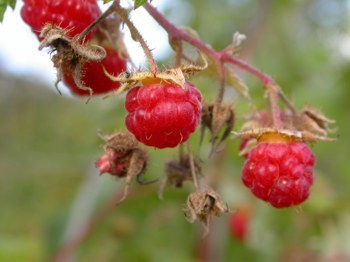Relatives
Rubus sachalinensis Levl. - Sakhalin raspberry.
Taxonomic position.
Family Rosaceae Juss. genus Rubus L.Synonyms.
Rubus idaeus subsp.sachalinensis (Levl.) Focke, R.idaeus var.microphyllus Turcz.Morphology and biology.
Erect semishrub, up to 1.5 (2) m high. First-year shoots are green, with glaucousness, covered with very dense, yellowish, fulvous or reddish thorns intermixed with numerous stalky glandules. Second-year offshoot are somewhat lignified, gray. Leaves are odd-pinnate, usually trifoliolate. Petioles are pilose, with aciculae and numerous stalky glandules. Leaflets are ovate-cordate or oblong-lanceolate, white tomentose from below, glandular or reddish, naked or pilose from above, with finely denticulate edges. Flowers are assembled in terminal or axillary oliganthous racemes. Peduncles, pedicels, hypanthia and sepals are setaceous, with numerous stalky glandules. Petals are white, shorter than sepals. Fruits are globular red polydrupes, 12-18 mm long and 10-14 mm wide, pilose, juicy.Entomophilous, ornito- and zoochore. Propagated by seed, root suckers or softwood cuttings. Blossoms in the second half of June or beginning of July, bears fruit in August. 2n=28.
Distribution.
Southeastern part of Western Siberia, greater part of Central and Eastern Siberia as well as the Russian Far East; Middle Asia (Tarbagatai); Mongolia; Northern China; North Korea. In the European part of Russia reaches the north of the Urals and Volga-Kama Region.Ecology.
Mesoxerophyte. Photophilous. Grows in sparse forests, on forest edges, glades and clearings, fire-sites and stony placers, rocks and riverbanks, either as single plants or in groups. Ascends the mountains into the subalpine (subgoltsy) belt - up to 1600 m above sea level in the Sayans, and up to 2200 m in Altai and Tuva.Utilization and economic value.
Food, medicinal and melliferous. Long ago known as a cultivated plant and one of the most valuable berry shrubs. Widely utilized in breeding practice. Raspberry fruits are consumed fresh or used to make jams and confectionary products.References:
Brezhnev, D.D., Korovina, O.N. 1981. Wild relatives of cultivated plants in the flora of the USSR. Leningrad: Kolos, pp.211-212. (in Russian).Koropachinskiy, I.Yu., Vstovskaya, T.N. 2002. Woody plants of the Asian part of Russia. Novosibirsk: Publishing House of SB RAS, Branch "Geo", pp.369-370 (in Russian).
Sokolov, S.I., Svjaseva, O.A., Kubli, V.A. 1980. Areas of distribution of trees and shrubs in the USSR. vol.2. Leningrad: Nauka, p.83 (in Russian).


